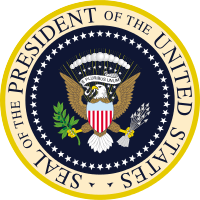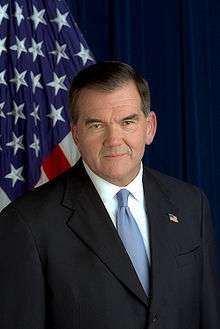United States Homeland Security Council
 | |
| Agency overview | |
|---|---|
| Formed | 2001 |
| Agency executives |
|
| Parent agency | Executive Office of the President of the United States |
The Homeland Security Council (HSC) is an entity within the Executive Office of the President of the United States tasked with advising the President on matters relating to Homeland Security. The current Homeland Security Advisor is Lisa Monaco who holds the rank of Assistant to the President for Homeland Security and Counterterrorism.
History
The Homeland Security Council (HSC) is an entity within the White House Office and was created by Executive Order 13228 on October 29, 2001, and subsequently expanded on by Homeland Security Presidential Directive 1.[1] It served as the successor to the Office of Homeland Security, established on September 20, 2001, immediately after the September 11 attacks. Congress subsequently codified the HSC in the Homeland Security Act of 2002, charging it with advising the President on homeland security matters.[2]
On February 23, 2009, the Obama administration released Presidential Study Directive 1. This memorandum ordered a 60-day inter-agency review of the White House homeland security and counter-terrorism structure. The review recommended that the president merge the staff supporting the Homeland Security Council with the staff supporting the National Security Council.[3][4] On May 26, 2009, Barack Obama signed the recommendation to merge the Homeland Security Council and National Security Council staffs into one National Security Staff. On February 10, 2014 President Obama renamed the National Security Staff the National Security Council (NSC) staff.[5]
Policymakers and observers have debated whether the HSC staff should remain an independent entity within the White House or merged with the NSC staff.[6] The HSC and NSC continue to exist by statute as independent councils of leadership advising the president.[7]
Mission
The Homeland Security Council is responsible for assessing the objectives, commitments, and risks of the United States, and for making recommendations to the president with respect to homeland security policy.
Structure
The HSC was similar to its national security counterpart, the National Security Council (NSC), which was established in the National Security Act of 1947. The HSC also maintained structural similarities with the NSC; the HSC consisted of full-time staff organized by subject areas relating to homeland security missions, with the Council itself being composed of Cabinet members and senior White House officials whose departments have principal interests in homeland security policy-making. The Joint Chiefs of Staff consist of the primary military advisers to the Homeland Security Council, as well as the National Security Council.[8] Due to the recommendations implemented by Obama, the Homeland Security Council and the National Security Council now have combined staff, the National Security Staff (NSS).
While similar in name, the Department of Homeland Security is a distinct federal executive department; unlike DHS, the HSC functioned as part of the Executive Office of the President, drawing staff from across federal agencies and under the direct control of the president.
Membership
| Structure of the United States Homeland Security Council (current) | |
|---|---|
| Chair | Barack Obama (President of the United States) |
| Statutory attendees | Joe Biden (Vice President of the United States) Jack Lew (Secretary of the Treasury) Ashton Carter (Secretary of Defense) Loretta Lynch (Attorney General) Sylvia Mathews Burwell (Secretary of Health and Human Services) Anthony Foxx (Secretary of Transportation) Jeh Johnson (Secretary of Homeland Security) Craig Fugate (Administrator of the Federal Emergency Management Agency) James Comey (Director of the Federal Bureau of Investigation) Lisa Monaco (Homeland Security Advisor) |
| Statutory military advisor | General Joseph Dunford (Chairman of the Joint Chiefs of Staff) |
| Additional attendees | Denis McDonough (Chief of Staff) Steve Ricchetti (Chief of Staff to the Vice President) Susan Rice (Assistant to the President for National Security Affairs) Shaun Donovan (Director of the Office of Management and Budget) |
| Occasional participants | John Kerry (Secretary of State) Tom Vilsack (Secretary of Agriculture) Sally Jewell (Secretary of the Interior) Ernest Moniz (Secretary of Energy) Thomas Perez (Secretary of Labor) Penny Pritzker (Secretary of Commerce) Robert A. McDonald (Secretary of Veterans Affairs) Gina McCarthy (Administrator of the Environmental Protection Agency) Jeffrey Zients (Assistant to the President for Economic Policy) Cecilia Munoz (Assistant to the President for Domestic Policy) |
United States Homeland Security Advisors
| # | Picture | Name | Term of office | President(s) served under | |
|---|---|---|---|---|---|
| Start | End | ||||
| 1 |  |
Tom Ridge | October 5, 2001 | January 24, 2003 | George W. Bush |
| 2 |  |
John A. Gordon | June 2003 | June 2004 | |
| 3 |  |
Frances M. Fragos Townsend | June 2004 | November 2007 | |
| 4 |  |
Kenneth L. Wainstein | March 30, 2008 | January 20, 2009 | |
| 5 |  |
John O. Brennan | January 20, 2009 | January 25, 2013 | Barack Obama |
| 6 |  |
Lisa Monaco | January 25, 2013 | Incumbent | |
References
- ↑ "Homeland Security Presidential Directive 1". Homeland Security Council. 29 October 2001. Retrieved 18 September 2009.
- ↑ P.L. 107-296, 116 Stat. 2135 (2002).
- ↑ Nichols, Hans (2009-03-05). "Obama Risks Cabinet Clashes to Expand National Security Council". Bloomberg.com. Retrieved 2012-05-17.
- ↑ DeYoung, Karen (February 27, 2009). "National Security Structure Is Set". Washingtonpost.com. Retrieved 2012-05-17.
- ↑ NSC Staff, the Name Is Back! So Long, NSS The White House. February 10, 2014.
- ↑ The Homeland Security Council: Considerations for the Future Frank Cilluffo and Daniel Kaniewski, Homeland Security Policy Institute. April 2009.
- ↑ In Security Shuffle, White House Merges Staffs
- ↑ 10 USC 151. Joint Chiefs of Staff: composition; functions
